
Stirling engine
Ce site appartient au réseau de sites relatifs aux moteurs à air chaud ou moteurs à apport de chaleur externe

Ce site appartient au réseau de sites relatifs aux moteurs à air chaud ou moteurs à apport de chaleur externe
For most of people, Robert Stirling is the father of the engine of the same name. In fact, it would be necessary to refer, first, to the regenerator or economiser. It is probably its principal invention. As one will see it below, the overall performance of the Stirling engine is related to the temperature difference between the hot source and the cold source, but very influenced by the regenerator.
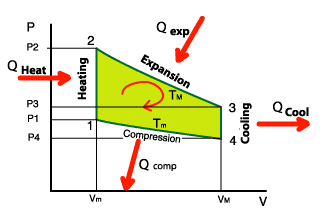
The diagram opposite shows us the 4 phases of operation:
- Heating with constant volume Vm(Gas temperature increase from Tm to TM)).
Thermal energy must be provided: Qheat.
- Expansion at constant temperature TM. Thermal energy must be provided to maintain gas in
temperature TM: Qexp.
- Cooling with constant volume VM(Gas temperature decrease from TM to Tm).
Thermal energy recovered is equal to Qcool. This one is the same one as that used to heat gas
with constant volume: Qcool = Qheat.
- Compression at constant temperature Tm. During this phase, one provides work but one recovers
thermal energy Qcomp.
Recovered mechanical energy is equal to the mechanical energy recovered during the expansion Wexp minus the mechanical energy Wcomp which one must provide for compress the gas. The energy recovered during a cycle is proportional to the surface coloured in green (see the page the principles).
Now, if our accounts are made (as a Scottish or an Auvergnat):
- one spends Qheat + Qexp
- for mechanical energies, one recovers Wexp - Wcomp
If one could recover Qcool to reinject it at the time of the constant volume heating,
one would save Qheat. The accounts would become:
- one spends Qexp
- for mechanical energies, one recovers Wexp - Wcomp
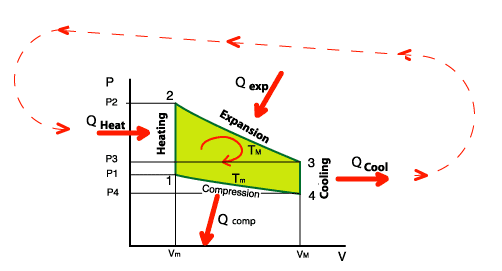
For the same mechanical profit, one spends less calories. The regenerator invented by Robert Stirling allows this economy!
It is what one can see on the diagram opposite. On a practical level, the regenerator is an heat exchanger situed between the hot source and the cold source. See the drawings below.
Actually, it is a delicate apparatus to conceive. The heat transfers with a gas are difficult and require cumbersome devices. The regenerator constitutes a “dead” volume which thwarts the benefit of its presence. There is never absolute truth!
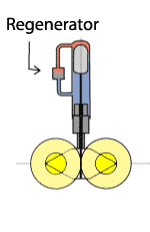
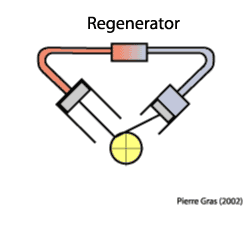
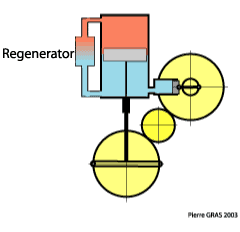
This site was created and is maintained by Pierre Gras.
Thank you with all the people who contributed their shares: articles, photographs, videos, worksheets.
The author is opened with any suggestion allowing to improve this site for happiness of everybody. Finally, a big
thank you to Robert Stirling !
"stirlinengine.fr" site by Pierre Gras is licensed under a
Creative Commons License
 .
.
This site meets XHTML and CSS standards. To get the best, use a browser such as Firefox, Chrome, Safari, Opera... they also adhere to these standards.